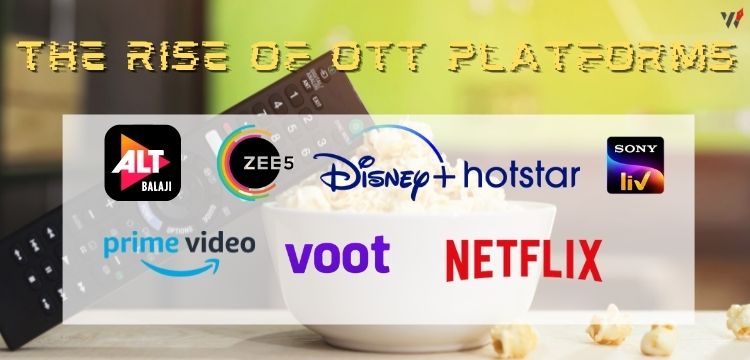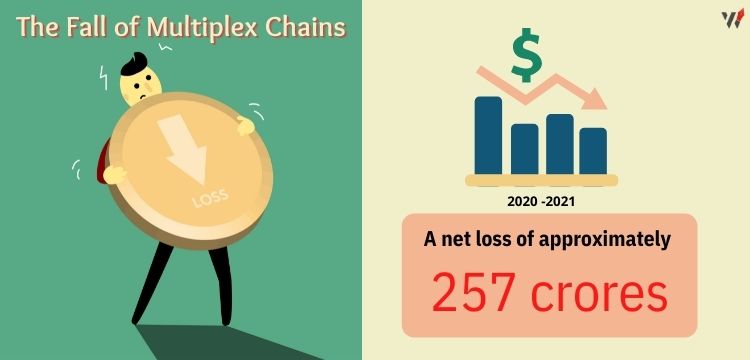With the striking of the COVID-19 Pandemic, people did not realize what being stuck at home meant until it came true. The pandemic forced people into the confined spaces of their homes, increasing family time. The realization and actually happening of being stuck inside one’s home for more than a necessary amount of time, it was a hard blow to the world. But that is when another set of global changes came about as well. Somehow, it lead to rise of OTT Platforms, will explain in a while.
The pandemic and its effects is not something that people, till today have easily recovered from. The first year, confining everyone to stay in their homes, or in whatever closed spaces that they were stuck in for an indefinite period of time was the scariest thing that the world has been through, globally, all at once and together after the world wars that were fought. It was something no one had a way out of. No one knew a way out of it either.
As much as it was negative, there were some positive effects to the pandemic as well. It increased awareness on mental health and its importance. It also greatly impacted family time and family bonding. The internet and technological world saw high booms and advancements. It became an almost comfortable life to lead, during the latter half of the second year of the crisis. Nothing seemed as scary and as disastrous anymore. By now, the world is almost back to normal.
Table of Contents
The Rise of OTT Platforms

Although the world of OTT Platforms has existed from the past five to seven years, the real boom in the industry was not until the coronavirus pandemic hit the world. Although platforms like Netflix were already quite well known, it is not a subscription that almost at least 70% of the population had. It was, at a time, considered a platform for the elite. Only something that the elites could afford deepening class divide and digital divide.
The pandemic helped in closing or reducing the barriers of the digital divide that exists throughout the world. A factor that has global effects. But if you look into the statistics of the viewership and increase in the business aspects of these OTT platforms, one can see the true role played by the pandemic. It was considered a real hero, almost, in these depressing and unpredictable times. Taking India as a country in context with the increase in OTT subscriptions, rural India alone, records almost 65% increase in these subscriptions and viewership.
The OTT platforms also form a much better and safer place than places like multiplex theaters. OTT platforms have the biggest advantage in its inclusivity. Not only regional content, but all kinds of international language content reaches you from anywhere to anywhere. It shortens global barriers and increases understanding of cultures, languages and inclusivity of all kinds, in the global (international) as well as domestic (national) levels. These platforms also give us 24/7 access to any kind of content, whether it is movies or tv shows compared to systems like the theater and the television.
The OTT platforms also found themselves to be a prospective space for content that they could specialize in. For example, certain shows are now limited to only OTT viewing, which means that if you do not have an OTT platform, there is no real legal way to watch the particular show. Even when it comes to movies, OTT platforms have bagged the rights of most movies and hence, if not in the theater, a person gets to watch that movie on an OTT platform, much much earlier and faster than on television.
OTT platforms have now become such a global success that it has now become a competitive field with several competitors striving to bring up their sales and subscriptions in more ways than one. The number of OTT platforms of Indian origin itself is now countless. Which means to say that in a global sphere, it is no more something easily quantifiable. But this also increases employment opportunities and provides an active and safe environment to content creators and content developers, despite regionality, nationality, etc.
Read blog About Best Movies on OTT: OTT BINGE LIST: BEST MOVIES ON OTT
The Fall of Multiplex Chains
PVR and Inox have been the largest multiplex chains in India for far too many years now. But the fall of such esteemed chains was not something anticipated by anybody. These chains have been the luxury theaters for generations and have minted their money through high sales value of tickets to comfortable, happy and luxury viewing with the best surround sound available. But today, after the rise of the global pandemic, these chains have seen nothing but imminent losses.
Theaters remaining shut for almost two years, have increased home comforts and luxuries of the people with OTT channels and online viewing through streaming platforms such as Netflix and others which have the highest demand of late. PVR and Inox multiplex chains are now mainly money making systems that have lost their reach to the people. These multiplex chains are now of use only for those movies that have 3D and other such effects. A good example of this, is the movie Spider-man No Way Home which demands a theater feel that no home nor OTT platform has to offer you.

Even statistical rates have shown the drastic decrease in the reach of theaters. The numbers clearly show the large downfall and the dangerous losses faced by multiplex chains such as PVR and INOX, among others. A net loss of approximately 257 crores was faced by these multiplex chains, taking alone the financial year of 2020-2021. The following year saw a hope of spike in numbers before the break out of the second lock-down, which proceeded to close the doors to the success or profits for these chains.
Now, theaters are again fully open and have a likelihood of increased success and profits. After almost two years, the opening of theaters, especially in the beginning, saw a sea or flood of people rushing in and booming initial losses back to desirable profits. Especially with the release of movies like Spiderman No Way Home and The Batman, theaters clearly hope to bring back their numbers and rise from their losses in all ways possible.
The PVR – Inox Merger

OTT platforms pose as the major threat to the working, resuming, smooth functioning as well as the success of theatres, namely multiplex chains such as PVR and Inox. This seems to be the most obvious cause of the latest news on the PVR – Inox merger that has been said to be going on.
With the record of losses from the past one and a half financial years, it is not shocking that such a merger is on going. With neither of the biggest multiplex chains of the country able to suffer the loss, the most obvious solution in redeeming numbers and bringing back profits is that of the merger held between PVR and Inox. The new brand post-merger will consist of both names and be called PVR INOX Ltd.
The merger not only seems to be the most appropriate and best solution to increase sales and profits. It also looks to be a win-win situation for both parties, that is, PVR and Inox. This merger would lead to sizable advantages from the post-COVID world that seems to be in full fledged and fully normal functioning of late. The merging of the two biggest theatre multiplex chains in the country also looks into advantages of material, revenue, costs along with relationships between film distributors, advertisement agencies as well as ticket aggregators.
Evidently sources say that PVR seems to be covering a debt issue while Inox seems to be rich in cash flow. Thus, the merger between the two chains only seeks and fulfills more balance among the two biggest multiplex chains of the country. The major result of the merger between PVR and Inox is the market share that seems to boom to 44% if the merger succeeds only in the box office revenue while also saving on corporate overheads.
Conclusion
The threat of OTT’s does not seem to be ignored by even the biggest multiplex chains of the country. The rise of OTT platforms are so real and have evolved so rapidly in just a span of one and a half to two years, that the merger between PVR and Inox seems to be a hurried response in order to save face and deal with bringing back desired profits. The sudden announcement of such a merger also seems to be a desperate measure, a kind of last resort of these multiplex chains to bring back the glory and the cash flow that seems to now be majorly threatened by the rise, popularity, demand and success of OTT platforms.
FAQ’s
- What is the reason behind the growth and popularity of OTT platforms?
The coronavirus opened people’s eyes to the convenience as well as the minimal requirements that OTT platforms demand whereas this does not seem to be the case with theaters and multiplex chains.
- How do OTT platforms and their producers make money?
OTT platforms as we all know demand payments from their audiences. This is done as a response to the platform spending money to buy its content. Hence, they charge their viewers a certain subscription fee. These platforms also spend money on advertisements and thus also acquire revenue from there.
- How long is the merger between PVR and Inox said to take?
The CCI board is the one that takes decisions and stances on theater chains. Thus, the CCI board has to give their approval for such a merger since PVR is a higher chain than Inox, it is said that there are chances for some issues to occur. Therefore, a good amount of time that it is said to take is around 6-8 months.





 WhatsApp
WhatsApp